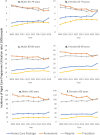Trends in the utilisation of aged care services in Australia, 2008-2016
- PMID: 31387533
- PMCID: PMC6685150
- DOI: 10.1186/s12877-019-1209-9
Trends in the utilisation of aged care services in Australia, 2008-2016
Abstract
Background: Aged care support services in Australia are delivered through home care packages, permanent residential care, respite care and transition care. This study aimed to determine age and gender specific incidence rates of aged care service utilisation in Australia between 2008-09 and 2015-16.
Methods: This is a population-based epidmiological study of people accessing aged care services in Australia. The trends and characteristics of people (over the age of 65 years old) accessing aged care services in Australia were evaluated, using data (2008-09 and 2015-16) from the Australian Institute of Health and Welfare and Australian Bureau of Statistics. The yearly utilisation incidence rates (per 1000 people) per service type were calculated and changes in incidence rate ratios (IRR) of service utilisation for the study period were estimated using Poisson regression models.
Results: The proportion of older Australians aged ≥65 years who used aged care services remained similar between 2008-09 (5.4%, N = 208,247) and 2015-16 (5.6%, N = 248,669). However, the incidence use of specific services changed during the study period. Specifically, admissions into permanent residential care decreased (from 23.8/1000 people in 2008-09 to 19.6/1000 in 2015-16, at a IRR of 0.84/year, p < 0.001) but increased for transition care (from 4.3/1000 in 2008-09 to 6.6/1000 in 2015-16, at a IRR of 1.57/year, p < 0.001) and home care packages (from 8.04/1000 in 2008-09 to 12.0/1000 per 1000 in 2015-16, at a IRR of 1.52/year, p < 0.001). Between 2008-09 and 2015-16, the greatest changes in IRR were observed in males aged 80-89 years accessing transition care (IRR = 1.68/year, p < 0.001). A higher proportion of people aged between 80-89 years (≥45%), females (≥60%), Australia born (≥ 60%) and English speakers (≥80%) used all the service types.
Conclusions: Patterns of service utilisation for aged care services changed over the study period with a decrease in incidence of individuals accessing permanent residential care but increased for other service types. This finding reflects changes in attitudes regarding ageing in place and policies. These findings are helpful to inform key stakeholders on service planning to further improve quality of the aged-care services in Australia.
Keywords: Aged care; Home care; Incidence rate; Permanent residential care; Respite care; Transition care; Utilisation.
Conflict of interest statement
The authors declare that they have no competing interests.
Figures



Similar articles
-
Young people in aged care: trends in the use of aged care services by younger Australians, 2008-2016.Disabil Rehabil. 2021 Apr;43(8):1153-1161. doi: 10.1080/09638288.2019.1652703. Epub 2019 Aug 28. Disabil Rehabil. 2021. PMID: 31460813
-
A greater risk of premature death in residential respite care: a national cohort study.Age Ageing. 2018 Mar 1;47(2):226-233. doi: 10.1093/ageing/afx177. Age Ageing. 2018. PMID: 29253078
-
Mortality in the first year of aged care services in Australia.Australas J Ageing. 2020 Dec;39(4):e537-e544. doi: 10.1111/ajag.12833. Epub 2020 Aug 20. Australas J Ageing. 2020. PMID: 32815606
-
Beset by obstacles: a review of Australian policy development to support ageing in place for people with intellectual disability.J Intellect Dev Disabil. 2008 Mar;33(1):76-86. doi: 10.1080/13668250701852433. J Intellect Dev Disabil. 2008. PMID: 18300170 Review.
-
Palliative care in residential aged care: An overview.Australas J Ageing. 2017 Dec;36(4):258-261. doi: 10.1111/ajag.12480. Epub 2017 Nov 15. Australas J Ageing. 2017. PMID: 29143495 Review.
Cited by
-
A mixed-methods study evaluating the impact of an excursion-based social group on quality of life of older adults.BMC Geriatr. 2021 Jun 10;21(1):356. doi: 10.1186/s12877-021-02295-7. BMC Geriatr. 2021. PMID: 34112098 Free PMC article.
-
Health status and healthcare trends of individuals accessing Australian aged care programmes over a decade: the Registry of Senior Australians historical cohort.Intern Med J. 2021 May;51(5):712-724. doi: 10.1111/imj.14871. Intern Med J. 2021. PMID: 32359019 Free PMC article.
-
Validation of a national leadership framework to promote and protect quality residential aged care: protocol for a Delphi study.BMJ Open. 2024 Jul 17;14(7):e083107. doi: 10.1136/bmjopen-2023-083107. BMJ Open. 2024. PMID: 39019630 Free PMC article.
-
The impact of outsourcing bed-based aged care services on quality of care: A multisite observational study.Int J Qual Health Care. 2022 Dec 8;34(4):mzac092. doi: 10.1093/intqhc/mzac092. Int J Qual Health Care. 2022. PMID: 36373866 Free PMC article.
-
Primary, allied health, selected specialists, and mental health service utilisation by home care recipients in Australia before and after accessing the care, 2017-2019.Aging Clin Exp Res. 2024 Mar 29;36(1):83. doi: 10.1007/s40520-024-02731-9. Aging Clin Exp Res. 2024. PMID: 38551712 Free PMC article.
References
-
- United Nations Department of Economic and Social Affairs Population Division . World Population Ageing 2015 (ST/ESA/SER.A/390). In., vol. (ST/ESA/SER.A/390) 2015.
-
- Australian Bureau of Statistics. Population Projections, Australia, 2012 (base) to 2101. https://www.abs.gov.au/ausstats/abs@.nsf/Lookup/3222.0main+features32012.... Accessed 30 Oct 2018.
-
- Commonwealth of Australia Department of Health. 2015–16 Report on the Operation of the Aged Care Act 1997. Canberra: Department of Health; 2016. https://agedcare.health.gov.au/sites/g/files/net1426/f/documents/12_2016....
-
- Australian Government, Australian Institute of Health and Welfare. Aged care: overview. https://www.aihw.gov.au/reports-data/health-welfare-services/aged-care/o.... Accessed 30 Oct 2018.
Publication types
MeSH terms
LinkOut - more resources
Full Text Sources
Medical

